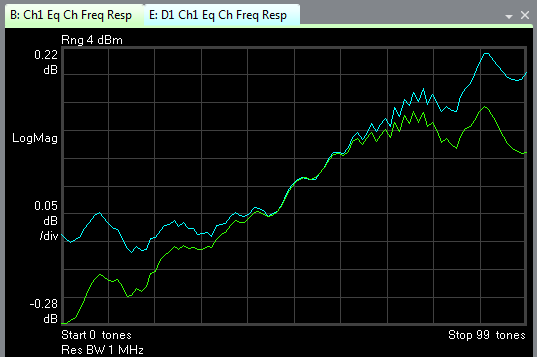Timing Adjust (Channel Quality)
sets the difference (in ppm) between the sample clock of the measured signal and the sample clock expected from the stimulus definition. The adjusted sample clock is calculated and displayed (grayed out) to the right.
Generally, you will use this parameter to adjust for minor differences between the transmitter's sample rate and the measurement hardware's sample rate.
Even a small symbol clock error (1-3 ppm) between transmit and receive can degrade the quality of the channel response results. To correct for any symbol clock error, enable averaging or increase the Analysis Interval until you get a stable reading of the value. Then set the parameter to the negative of the value.
How to determine if Clock Error is impacting your channel frequency response measurements:
The primary measurement artifact of uncompensated Clock Error will be degraded accuracy of the channel frequency response measurement. Specifically, the frequency response estimates for tones towards the edges of the stimulus bandwidth will be attenuated. Below is a comparison of the channel response measurements for a 100 MHz Megahertz: A unit of frequency equal to one million hertz or cycles per second. stimulus with a 2 PPM 1) Parts Per Million or 2) pulse position modulation Clock Error and a 1 ms Analysis Interval, overlaid with the same measurement with a zero Clock Error stimulus.
Notice the 0.15 dB attenuation at the edges of the stimulus spectrum.

An independent approach to identify this inaccuracy is to view the Tracking Response results. If Clock Error is impacting the measurement results, a clear parabolic trend can be observed in the Tracking Response magnitude results. Below shows the Tracking Response results when a 2PPM Clock Error is present for a 100 MHz stimulus with a 2 PPM Clock Error and a 1 ms Analysis Interval, overlaid with the same measurement with a zero Clock Error stimulus.
![]()
To compensate for this affect, add the negated contents of Clock Error (as presented on the Summary table, in this case 2.0 PPM)into the Timing Adjust property.
See Also
